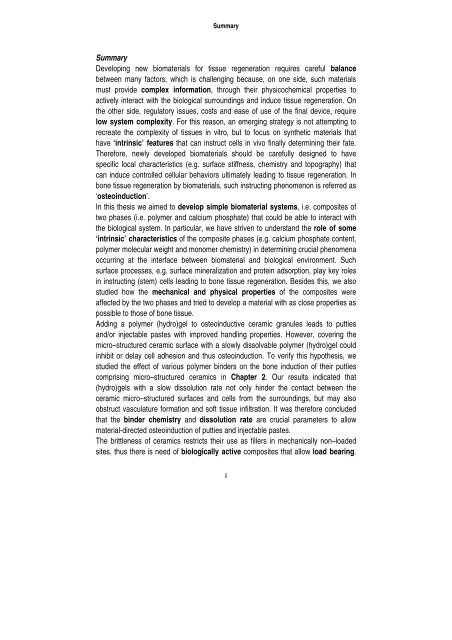Barbieri Thesis - BioMedical Materials program (BMM)
Barbieri Thesis - BioMedical Materials program (BMM)
Barbieri Thesis - BioMedical Materials program (BMM)
You also want an ePaper? Increase the reach of your titles
YUMPU automatically turns print PDFs into web optimized ePapers that Google loves.
Summary<br />
Summary<br />
Developing new biomaterials for tissue regeneration requires careful balance<br />
between many factors, which is challenging because, on one side, such materials<br />
must provide complex information, through their physicochemical properties to<br />
actively interact with the biological surroundings and induce tissue regeneration. On<br />
the other side, regulatory issues, costs and ease of use of the final device, require<br />
low system complexity. For this reason, an emerging strategy is not attempting to<br />
recreate the complexity of tissues in vitro, but to focus on synthetic materials that<br />
have ‘intrinsic’ features that can instruct cells in vivo finally determining their fate.<br />
Therefore, newly developed biomaterials should be carefully designed to have<br />
specific local characteristics (e.g. surface stiffness, chemistry and topography) that<br />
can induce controlled cellular behaviors ultimately leading to tissue regeneration. In<br />
bone tissue regeneration by biomaterials, such instructing phenomenon is referred as<br />
‘osteoinduction’.<br />
In this thesis we aimed to develop simple biomaterial systems, i.e. composites of<br />
two phases (i.e. polymer and calcium phosphate) that could be able to interact with<br />
the biological system. In particular, we have striven to understand the role of some<br />
‘intrinsic’ characteristics of the composite phases (e.g. calcium phosphate content,<br />
polymer molecular weight and monomer chemistry) in determining crucial phenomena<br />
occurring at the interface between biomaterial and biological environment. Such<br />
surface processes, e.g. surface mineralization and protein adsorption, play key roles<br />
in instructing (stem) cells leading to bone tissue regeneration. Besides this, we also<br />
studied how the mechanical and physical properties of the composites were<br />
affected by the two phases and tried to develop a material with as close properties as<br />
possible to those of bone tissue.<br />
Adding a polymer (hydro)gel to osteoinductive ceramic granules leads to putties<br />
and/or injectable pastes with improved handling properties. However, covering the<br />
micro–structured ceramic surface with a slowly dissolvable polymer (hydro)gel could<br />
inhibit or delay cell adhesion and thus osteoinduction. To verify this hypothesis, we<br />
studied the effect of various polymer binders on the bone induction of their putties<br />
comprising micro–structured ceramics in Chapter 2. Our results indicated that<br />
(hydro)gels with a slow dissolution rate not only hinder the contact between the<br />
ceramic micro–structured surfaces and cells from the surroundings, but may also<br />
obstruct vasculature formation and soft tissue infiltration. It was therefore concluded<br />
that the binder chemistry and dissolution rate are crucial parameters to allow<br />
material-directed osteoinduction of putties and injectable pastes.<br />
The brittleness of ceramics restricts their use as fillers in mechanically non–loaded<br />
sites, thus there is need of biologically active composites that allow load bearing.<br />
i





